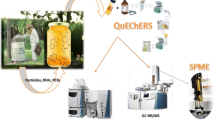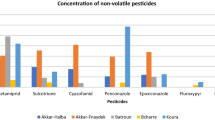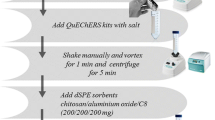Abstract
As a result of growing concern regarding the disappearance of pollinators, numerous studies have been carried out in different countries in an attempt to find the causes of this phenomenon. A large part of this study is aimed at justifying this concern due to the presence of pesticide residues from the crops visited by bees. In particular, neonicotinoid insecticides have been identified as one potential cause, and three of these (thiamethoxam, clothianidin, and imidacloprid) have been banned by the European Authorities. Therefore, the determination of these insecticides in different matrices, whether they be food, environmental, etc., is an important current object of study. In this chapter, we summarize the analytical methods and the most relevant findings of four recent publications devoted to developing and validating specific analytical methods for determining neonicotinoid insecticides in different bee products, namely, honey, beeswax, bee pollen, and royal jelly. In all cases, ultra-high-pressure liquid chromatography methods coupled with tandem mass spectrometry were employed, and different sample treatments were proposed depending on the bee matrix studied. These included solid-phase extraction (honey and royal jelly), Quick, Easy, Cheap, Effective, Rugged, and Safe based-methodologies (bee pollen and honey), solvent extraction combined with dispersive solid-phase extraction (beeswax), and dispersive liquid–liquid microextraction (royal jelly). All the methods were fully validated and applied to an analysis of samples from different origins, namely, experimental and commercial apiaries.
Access this chapter
Tax calculation will be finalised at checkout
Purchases are for personal use only
Similar content being viewed by others
Abbreviations
- ACET:
-
Acetamiprid
- ACN:
-
Acetonitrile
- AF:
-
Samples spiked after sample treatment
- BF:
-
Samples spiked before sample treatment
- CAR:
-
Centro Apícola Regional
- CLO:
-
Clothianidin
- DAD:
-
Diode array detector
- DLLME:
-
Dispersive liquid-liquid microextraction
- DN:
-
Dinetofuran
- dSPE:
-
Dispersive solid-phase extraction
- EIC:
-
Extracted ion chromatogram
- EMR-lipid:
-
Enhanced matrix removal-lipid
- ESI:
-
Electrospray ionization
- GC:
-
Gas chromatography
- HPLC:
-
High-performance liquid chromatography
- IMI:
-
Imidacloprid
- IS:
-
Internal standard
- LOD:
-
Limit of detection
- LOQ:
-
Limit of quantification
- MS:
-
Mass spectrometry
- MS/MS:
-
Tandem mass spectrometry
- NEOs:
-
Neonicotinoids
- NT:
-
Nitenpyram
- PSA:
-
Primary secondary amine
- QC:
-
Quality control
- QTOF:
-
Quadrupole time-of-flight
- QuEChERS:
-
Quick, Easy, Cheap, Effective, Rugged, and Safe
- SE:
-
Solvent extraction
- THIA:
-
Thiacloprid
- TMX:
-
Thiamethoxam
- UHPLC:
-
Ultra-high-performance liquid chromatography
References
Liang H, Zao CL, Huang F, Bai RE, Lü YB, Yan FM, Hao ZP (2015) Effects of imidacloprid and thiamethoxam as seed treatments on the early seedling characteristics and aphid-resistance of oilseed rape. J Integr Agric 14:2581–2589
Yáñez KP, Martín MT, Bernal JL, Nozal MJ, Bernal J (2014) Trace analysis of seven neonicotinoid insecticides in bee pollen by solid–liquid extraction and liquid chromatography coupled to electrospray ionization mass spectrometry. Food Anal Methods 7:490–497
Kasiotis KM, Anagnostopoulos C, Anastasiadou P, Machera K (2014) Pesticide residues in honeybees, honey and bee pollen by LC-MS/MS screening: reported death incidents in honeybees. Sci Total Environ 485-486:633–642
Yáñez KP, Bernal JL, Nozal MJ, Martín MT, Bernal J (2013) Determination of seven neonicotinoid insecticides in beeswax by liquid chromatography coupled to electrospray-mass spectrometry using a fused-core column. J Chromatogr A 1285:110–117
Chen M, Collins EM, Tao L, Lu C (2013) Simultaneous determination of residues in pollen and high-fructose corn syrup from eight neonicotinoid insecticides by liquid chromatography-tandem mass spectrometry. Anal Bioanal Chem 405:9251–9264
Parrilla-Vázquez P, Lozano A, Uclés S, Gómez-Ramos MM, Fernández-Alba AR (2015) A sensitive and efficient method for routine pesticide multiresidue analysis in bee pollen samples using gas and liquid chromatography coupled to tandem mass spectrometry. J Chromatogr A 1426:161–173
Mullin CA, Frazier M, Frazier JL, Ashcraft S, Simonds R, vanEngelsdorp D, Pettis JS (2010) High levels of miticides and agrochemicals in North American apiaries: implications for honey bee health. PLoS One 5:e9754
Fairbrother A, Purdy J, Anderson T, Fell R (2014) Risks of neonicotinoid insecticides to honeybees. Environ Toxicol Chem 33:719–731
VanEngelsdorp D, Evans C, Evans JD, Saegerman C, Mullin C, Haubruge E, Nguyen BK, Frazier M, Frazier J, Cox-Foster D, Chen Y, Underwood R, Tarpy D, Pettis J (2009) Colony collapse disorder: a descriptive study. PLoS One 4:1–17
Lawal A, Wong RCS, Tan GH, Abdulra’uf LB, Alsharif AMA (2018) Recent modifications and validation of QuEChERS-dSPE coupled to LC–MS and GC–MS instruments for determination of pesticide/agrochemical residues in fruits and vegetables: review. J Chromatogr Sci 56:656–669
Garrido-Frenich AG, Romero-González R, Aguilera-Luiz MM (2014) Comprehensive analysis of toxics (pesticides, veterinary drugs and mycotoxins) in food by UHPLC-MS. TRAC-Trend Anal Chem 63:158–169
Madej K, Kalenik TK, Piekoszewski W (2018) Sample preparation and determination of pesticides in fat-containing foods. Food Chem 269:527–541
Jiménez-López J, Llorent-Martínez EJ, Ortega-Barrales P, Ruiz-Medina A (2020) Analysis of neonicotinoid pesticides in the agri-food sector: a critical assessment of the state of the art. Appl Spectrosc Rev 58:613–646
Tu X, Chen W (2020) Overview of analytical methods for the determination of neonicotinoid pesticides in honeybee products and honeybee. Crit Rev Anal Chem. https://doi.org/10.1080/10408347.2020.1728516
Valverde S, Bernal JL, Martín MT, Nozal MJ, Bernal J (2016) Fast determination of neonicotinoid insecticides in bee pollen using QuEChERS and ultra-high performance liquid chromatography coupled to quadrupole time-of-flight mass spectrometry. Electrophoresis 37:2470–2477
Valverde S, Ares AM, Bernal JL, Nozal MJ, Bernal J (2018) Fast determination of neonicotinoid insecticides in beeswax by ultra-high performance liquid chromatography-tandem mass spectrometry using an enhanced matrix removal-lipid sorbent for clean-up. Microchem J 142:70–77
Valverde S, Ibáñez M, Bernal JL, Nozal MJ, Hernández F, Bernal J (2018) Development and validation of ultra high performance-liquid chromatography–tandem mass spectrometry-based methods for the determination of neonicotinoid insecticides in honey. Food Chem 266:215–222
Valverde S, Ares AM, Arribas M, Bernal JL, Nozal MJ, Bernal J (2018) Development and validation of UHPLC–MS/MS methods for determination of neonicotinoid insecticides in royal jelly-based products. J Food Compos Anal 70:105–113
Michlig MP, Merke J, Pacini A, Orellano E, Beldoménico HR, Repetti MR (2018) Determination of imidacloprid in beehive samples by UHPLC-MS/MS. Microchem J 143:72–81
Hrynko I, Łozowicka B, Kaczyński P (2018) Liquid chromatographic MS/MS analysis of a large group of insecticides in honey by modified QuEChERS. Food Anal Methods 11:2307–2319
Kamel A (2010) Refined methodology for the determination of neonicotinoid pesticides and their metabolites in honey bees and bee products by liquid chromatography-tandem mass spectrometry (LC-MS/MS). J Agric Food Chem 58:5926–5831
Alarcón-Flores MI, Romero-González R, Martínez Vidal JL, Garrido Frenich A (2013) Multiclass determination of phytochemicals in vegetables and fruits by ultra high performance liquid chromatography coupled to tandem mass spectrometry. Food Chem 141:1120–1129
Bernal J, González D, Valverde S, Toribio L, Ares AM (2019) Improved separation of intact glucosinolates in bee pollen by using ultra-high-performance liquid chromatography coupled to quadrupole time-of-flight mass spectrometry. Food Anal Methods 12:1170–1178
Glauser G, Schweizer F, Turlings TCJ, Reymond P (2012) Rapid profiling of intact glucosinolates in Arabidopsis leaves by UHPLC–QTOFMS using a charged surface hybrid column. Phytochem Anal 23:520–528
European Commission Directorate-General for Health and Food Safety, Document SANTE/12682/2019 (2019) https://www.eurl-pesticides.eu/userfiles/file/EurlALL/AqcGuidance_SANTE_2019_12682.pdf. Accessed 4 May 2021
EURACHEM (2014) EURACHEM guide: the fitness for purpose of analytical methods—a laboratory guide to method validation and related topics. https://www.eurachem.org/images/stories/Guides/pdf/MV_guide_2nd_ed_EN.pdf. Accessed 4 May 2021
David A, Botías C, Abdul-Sada A, Goulson D, Hill EM (2015) Sensitive determination of mixtures of neonicotinoid and fungicide residues in pollen and single bumblebees using a scaled down QuEChERS method for exposure assessment. Anal Bioanal Chem 407:8151–8162
Moreno-González D, Alcántara-Durán J, Gilbert-López B, Beneito-Cambra M, Cutillas VM, Rajski LR, Molina-Díaz A, García-Reyes AM (2019) Sensitive detection of neonicotinoid insecticides and other selected pesticides in pollen and nectar using nanoflow liquid chromatography orbitrap tandem mass spectrometry. J AOAC Int 101:367–373
Hall MJ, Dang V, Bradbury SP, Coats JR (2020) Optimization of QuEChERS method for simultaneous determination of neonicotinoid residues in pollinator forage. Molecules 25:2732
Codling G, Al Naggar Y, Giesy JP, Robertson AJ (2016) Concentrations of neonicotinoid insecticides in honey, pollen and honey bees (Apis mellifera L.) in central Saskatchewan, Canada. Chemosphere 144:2321–2328
Li H, Yin J, Liu Y, Shang L (2012) Effect of protein on the detection of fluoroquinolone residues in fish meat. J Agric Food Chem 60:1722–1727
Niell S, Cesio V, Hepperle J, Doerk D, Kirsch L, Kolberg D, Scherbaum E, Anastassiades M, Heinzen H (2014) QuEChERS-based method for the multiresidue analysis of pesticides in beeswax by LC-MS/MS and GC×GC-TOF. J Agric Food Chem 62:3675–3683
Harriet J, Campá JP, Grajales M, Lhéritier C, Gómez Pajuelo A, Mendoza-Spina Y, Carrasco-Letelier L (2017) Agricultural pesticides and veterinary substances in Uruguayan beeswax. Chemosphere 177:77–83
Herrera López S, Lozano A, Sosa A, Hernando MD, Fernández-Alba AR (2016) Screening of pesticide residues in honeybee wax comb by LC-ESI-MS/MS. A pilot study. Chemosphere 163:44–53
Kaczyński P, Hrynko I, Łozowicka B (2017) Evolution of novel sorbents for effective clean-up of honeybee matrix in highly toxic insecticide LC/MS/MS analysis. Ecotoxicol Environ Saf 139:124–131
Al Naggar Y, Codling G, Giesy JP (2017) Human dietary intake and hazard characterization for residues of neonicotinoids and organophosphorus pesticides in Egyptian honey. Toxicol Environ Chem 99:1397–1408
Tette PA, da Silva Oliveira FA, Pereira EN, Silva G, de Abreu Glória MB, Fernandes C (2016) Multiclass method for pesticides quantification in honey by means of modified QuEChERS and UHPLC–MS/MS. Food Chem 211:130–139
Sánchez-Hernández L, Hernández D, Martín MT, Nozal MJ, Higes M, Bernal JL (2016) Residues of neonicotinoids and their metabolites in honey and pollen from sunflower and maize seed dressing crops. J Chromatogr A 1428:220–227
Jovanov P, Guzsvány V, Franko M, Lazić S, Sakač M, Milovanović I, Nedeljković N (2014) Development of multiresidue DLLME and QuEChERS based LC-MS/MS methods for determination of selected neonicotinoid insecticides in honey liqueur. Food Res Int 55:11–19
Hayes R, Ahmed A, Edge T, Zhang H (2014) Core-shell particles: preparation, fundamentals and applications in high performance liquid chromatography. J Chromatogr A 1357:36–52
Totti S, Fernández M, Ghini S, Picó Y, Fini F, Mañes J, Girotti S (2006) Application of matrix solid phase dispersion to the determination of imidacloprid, carbaryl, aldicarb, and their main metabolites in honeybees by liquid chromatography–mass spectrometry detection. Talanta 69:724–729
Bonmatin JM, Moineau I, Charvet R, Fleche C, Colin ME, Bengsch ER (2003) A LC/APCI-MS/MS method for analysis of imidacloprid in soils, in plants and in pollens. Anal Chem 75:2027–2033
Yáñez KP, Bernal JL, Nozal MJ, Martín MT, Bernal J (2013) Fast determination of imidacloprid in beeswax by liquid chromatography coupled to electrospray-mass spectrometry. Curr Anal Chem 9:495–503
Hou J, Xie W, Zhang W, Li F, Qian Y, Sheng T, Mao R, Yao X (2019) Simultaneous determination of neonicotinoid insecticides and two metabolites in royal-jelly by LC-MS/MS. J Chinese Mass Spectr Soc 40:139–150
European Union Pesticide Database. Current MRLs values. Active substances detail. https://ec.europa.eu/food/plant/pesticides/eu-pesticides-database/active-substances/?event=search.as. Accessed 4 May 2021
Author information
Authors and Affiliations
Corresponding author
Editor information
Editors and Affiliations
Rights and permissions
Copyright information
© 2022 The Author(s), under exclusive license to Springer Science+Business Media, LLC, part of Springer Nature
About this protocol
Cite this protocol
Valverde, S., Ares, A.M., Bernal, J.L., Nozal, M.J., Bernal, J. (2022). Determination of Neonicotinoid Insecticides in Bee Products by Using Ultra-High-Performance Liquid Chromatography–Tandem Mass Spectrometry. In: Gallardo, E., Barroso, M. (eds) Pesticide Toxicology. Methods in Pharmacology and Toxicology. Humana, New York, NY. https://doi.org/10.1007/978-1-0716-1928-5_2
Download citation
DOI: https://doi.org/10.1007/978-1-0716-1928-5_2
Published:
Publisher Name: Humana, New York, NY
Print ISBN: 978-1-0716-1927-8
Online ISBN: 978-1-0716-1928-5
eBook Packages: Springer Protocols




